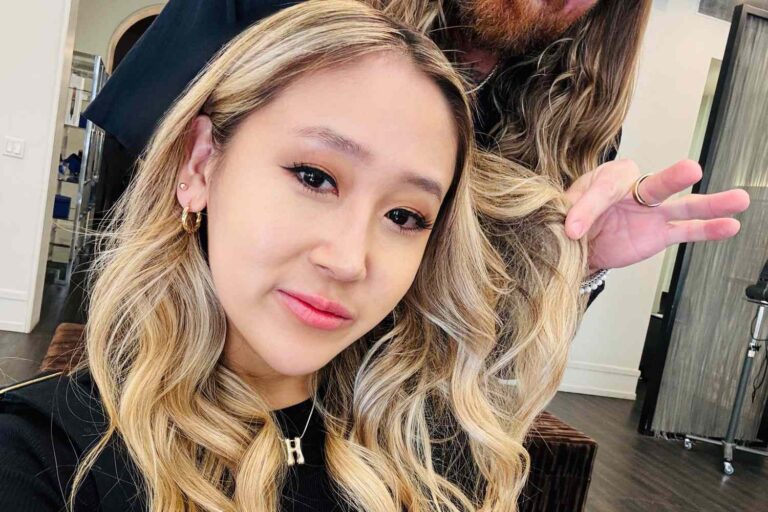For as long as I can remember, I’ve wanted to be blonde. But I held out for a long time because I got scared of bleach after hearing so many horror stories from friends with unnatural blonde hair. For a while I tried to lighten it as much as possible without using bleach, and my very dark hair turned chocolate brown, but eventually I gave in to my desire to go blonde and took the plunge and went to the salon.
But I was determined that if I was going to do this, I was going to do it right. I like my hair long (I consider it a security blanket of sorts). We all know that long blonde hair is difficult to maintain. That meant I had to go the least damaging route possible, which I feared was an impossible feat. Luckily, I knew some great colorists who could provide guidance. Among them is Michelle Hong, professional colorist and founder of NYC The Team Hair Salon. He is an Asian blonde hair expert like me and helped me keep my hair blonde and healthy.
Here are the questions I asked and what I learned.
How long does it take for Asian hair to turn blonde?
If you have naturally very thick hair, the first thing to know is that it’s not a one-and-done thing. In other words, if you’re sitting on the chair for the first time, don’t expect to come out blonde. However, that’s a good thing. To keep your hair healthy and prevent major hair breakage, you should divide the bleaching process into multiple sessions.
“The number of sessions needed to achieve blonde hair depends on whether your hair has color or is your natural virgin hair,” says Hong. “Asian hair is usually very dark and the texture is thicker. The darker and thicker the hair, the more red you need to accentuate to achieve neutral blonde, non-blond highlights. ”
My hair after the session 1. My hair after the session 2.
As someone with medium-thick black hair (not to mention having pre-existing color on half of my hair), it took me about four sessions to reach my desired blonde shade. Generally, it’s recommended to wait at least two weeks between sessions to replenish hair hydration (I waited a month to be safe).
Why does Asian hair tend to turn orange or red, and how can we avoid this?
The biggest problem with Asian hair is that when bleached, it tends to turn blonde with orange or red undertones. “Asian hair naturally has an underlying red and orange pigment, so it’s important for colorists to take this into consideration in the salon,” says Hong. “How you lift Asian hair is important. To get the perfect shade, you need to consider the strength, timing, and application method of the lightener.”
We recommend doing your research and consulting a colorist who has particular experience with Asian hair. Even the most experienced colorist may not be used to lightening Asian hair, and the color may look different compared to other clients. You don’t want any sink surprises, so look at salons’ Instagrams to find one that has before and afters similar to the style you’re going for.
Get there slowly.
What is the best way to maintain blonde hair for Asians?
No matter how well you bleach your hair, bleach is inherently damaging. “There will be some drying and it will be more susceptible to breakage,” Hong says. “Be sure to use bond builders, strengthening masks, and anti-breakage serums to repair your hair. It’s important to be gentle when washing, brushing, and blow-drying.” Like K18 and Olaplex We recommend incorporating the brand into your daily life on a regular basis.
Another maintenance factor is that no matter how beautiful the blonde is, it always happens when you leave the salon. This is where purple shampoo and purple masks come into play. Add these to your shower routine two to three times a week to counteract any orange or red undertones.
The last thing to do is establish a maintenance schedule with your colorist. You want to go as long between appointments as possible (root sprays can extend this time), but the sweet spot is every 6 to 8 weeks. Hair typically grows about half an inch per month, so your hair will grow about an inch longer in that period. If it’s longer than that, the color develops unevenly due to the difference in heat from the scalp, which can result in bands or “hot roots” (when the root color is lighter than the rest of the hair).
“The longer the roots, the harder it is to lighten. If you regrow more than an inch, you will need to lighten your hair twice. This will add even more light to the overlapped areas of your already lightened hair. A lot of damage is done,” Hong said.
remove
My hair now.
It is difficult to make Asian hair blonde, but it is absolutely possible. First and foremost, do your research and be sure to find your own personal Michelle (i.e., an expert to guide you through the steps). Monitor your expectations and expect to transform into the attractive blonde you’re looking for in multiple sessions (going from black to blonde is no easy task). And finally, prepare for maintenance. Asian hair can easily turn orange, so there are a lot of them, but considering the added fun you can prove as a blonde, it’s definitely worth it.

